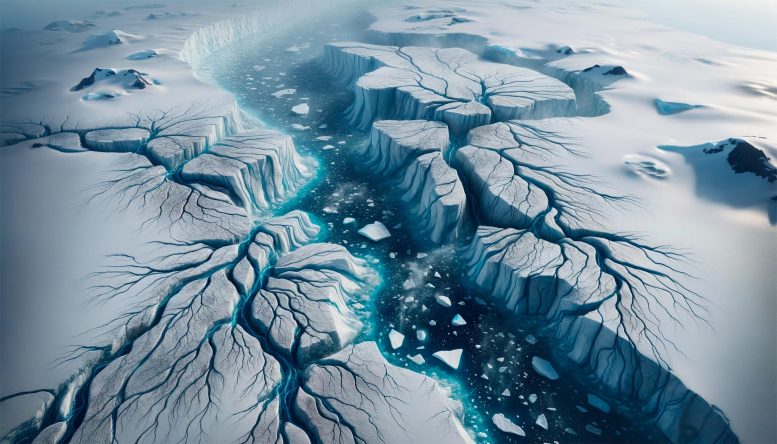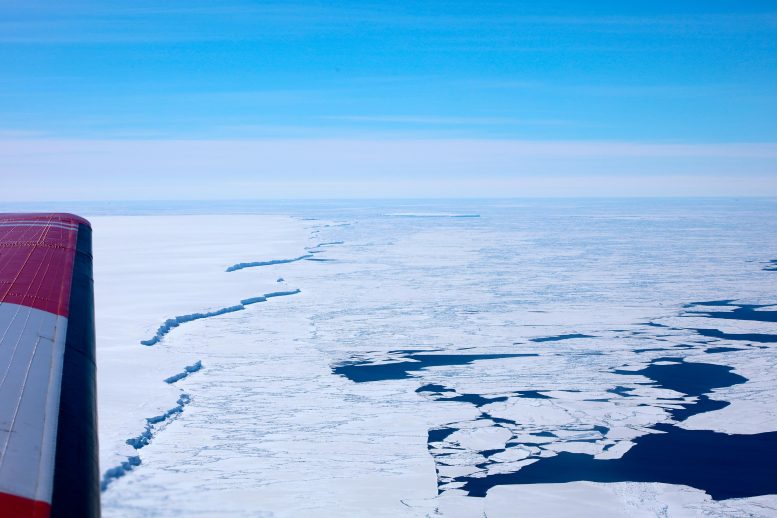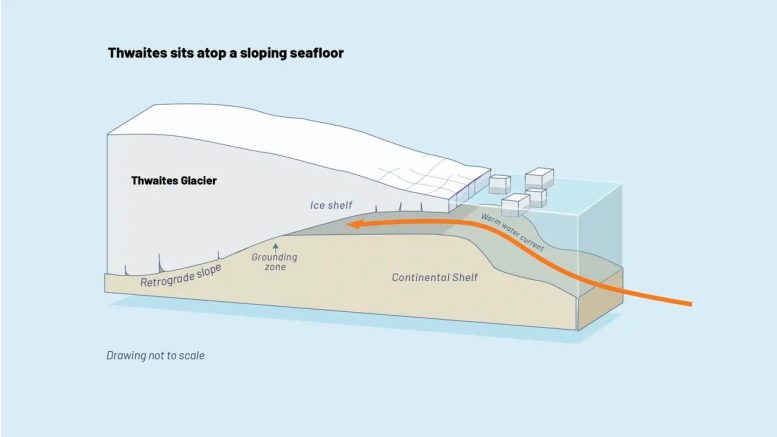
A study from UC San Diego’s Scripps Institution of Oceanography indicates that meltwater flowing beneath Antarctic glaciers accelerates their ice loss. This effect, termed subglacial discharge, could significantly impact global sea-level rise predictions, particularly if high greenhouse gas emissions continue.
Simulations showed that meltwater flowing beneath Antarctic glaciers accelerated sea-level rise by 15% by 2300, suggesting it should be factored into future projections.
A new Antarctic ice sheet modeling study from scientists at UC San Diego’s Scripps Institution of Oceanography suggests that meltwater flowing out to sea from beneath Antarctic glaciers is making them lose ice faster.
The model’s simulations suggest this effect is large enough to make a meaningful contribution to global sea-level rise under high greenhouse gas emissions scenarios.
The extra ice loss caused by this meltwater flowing out to sea from beneath Antarctic glaciers is not currently accounted for in the models generating major sea-level rise projections, such as those of the Intergovernmental Panel on Climate Change (IPCC). If this process turns out to be an important driver of ice loss across the entire Antarctic ice sheet, it could mean current projections underestimate the pace of global sea-level rise in decades to come.
Implications for Coastal Communities
“Knowing when and how much global sea-level will rise is critical to the welfare of coastal communities,” said Tyler Pelle, the study’s lead author and a postdoctoral researcher at Scripps. “Millions of people live in low-lying coastal zones and we can’t adequately prepare our communities without accurate sea-level rise projections.”
The study, published on October 27 in Science Advances and funded by the National Science Foundation (NSF), NASA, and the Cecil H. and the Ida M. Green Foundation for Earth Sciences at the Institute of Geophysics and Planetary Physics at Scripps, modeled the retreat of two glaciers in East Antarctica through the year 2300 under different emissions scenarios and projected their contributions to sea-level rise. Unlike previous Antarctic ice sheet models, this one included the influence of this flow of meltwater from beneath glaciers out to sea, which is known as subglacial discharge.
Model Predictions and Findings
The two glaciers the study focused on, named Denman and Scott, together hold enough ice to cause nearly 1.5 meters (5 feet) of sea-level rise. In a high emissions scenario (IPCC’s SSP5-8.5 scenario, which assumes no new climate policy and features 20% higher CO2 emissions by 2100), the model found that subglacial discharge increased the sea-level rise contribution of these glaciers by 15.7%, from 19 millimeters (0.74 inches) to 22 millimeters (0.86 inches) by the year 2300.
These glaciers, which are right next to each other, sit atop a continental trench that is more than two miles deep; once their retreat reaches the trench’s steep slope, their contribution to sea-level rise is expected to accelerate dramatically. With the added influence of subglacial discharge, the model found that the glaciers retreated past this threshold about 25 years earlier than they did without it.
“I think this paper is a wake-up call for the modeling community. It shows you can’t accurately model these systems without taking this process into account,” said Jamin Greenbaum, co-author of the study and a researcher at Scripps’ Institute of Geophysics and Planetary Physics.
A key takeaway, beyond the understudied role of subglacial discharge in accelerating sea-level rise, is the importance of what humanity does in the coming decades to rein in greenhouse gas emissions, said Greenbaum. The low emissions scenario runs of the model did not show the glaciers retreating all the way into the trench and avoided the resulting runaway contributions to sea-level rise.
“If there is a doomsday story here it isn’t subglacial discharge,” said Greenbaum. “The real doomsday story is still emissions and humanity is still the one with its finger on the button.”
Understanding Subglacial Discharge
In Antarctica, subglacial meltwater is generated from melting that occurs where the ice sits on continental bedrock. The main sources of the heat melting the ice in contact with the ground are friction from the ice grinding across the bedrock and geothermal heat from Earth’s interior permeating up through the crust.
Prior research suggested that subglacial meltwater is a common feature of glaciers around the world and that it is present under several other massive Antarctic glaciers, including the infamous Thwaites Glacier in West Antarctica.
When subglacial discharge flows out to sea it is thought to accelerate melting of the glacier’s ice shelf – a long floating tongue of ice that extends out to sea beyond the last part of the glacier that is still in contact with solid ground (known as the grounding line). Subglacial discharge is thought to speed up ice shelf melting and glacial retreat by causing ocean mixing that stirs in additional ocean heat within the cavity beneath a glacier’s floating ice shelf. This enhanced ice shelf melting then causes the upstream glacier to accelerate, which can drive sea level rise.
The notion that subglacial discharge causes additional ice shelf melting is widely accepted in the scientific community, said Greenbaum. But it hasn’t been included in sea-level rise projections because many researchers weren’t sure if the process’ effect was sufficiently large to increase sea-level rise, mainly because its effects are localized around the glacier’s ice shelf.
Pelle said subglacial discharge came onto his radar in 2021 when he and his colleagues observed that East Antarctica’s Denman Glacier’s ice shelf was melting faster than expected given local ocean temperatures. Puzzlingly, Denman’s neighbor Scott Glacier’s ice shelf was melting much more slowly despite virtually identical ocean conditions.
Modeling Challenges and Future Research
To test whether subglacial discharge could reconcile the melt rates seen at the Denman and Scott ice shelves, as well as whether subglacial meltwater might accelerate sea-level rise, the team combined models for three different environments: the ice sheet, the space between the ice sheet and bedrock, and the ocean.
Once the researchers married the three models into one they ran a series of projections up to 2300 using a NASA supercomputer.
The projections featured three main scenarios: a control that featured no additional ocean warming, a low emissions pathway (SSP1-2.6), and a high emissions pathway (SSP5-8.5). For each scenario, the researchers created projections with and without the effect of present-day levels of subglacial discharge.
The model’s simulations revealed that adding in subglacial discharge reconciled the melt rates seen at Denman and Scott Glaciers. As for why Scott Glacier was melting so much slower than Denman, Pelle said the model showed that “a strong subglacial discharge channel drained across the Denman Glacier grounding line, while a weaker discharge channel drained across the Scott Glacier grounding line.” The strength of the discharge channel at Denman, Pelle explained, was behind its speedy melt.
For the control and low-emissions model runs the contributions to sea-level rise were close to zero or even slightly negative with or without subglacial discharge at 2300. But in a high emissions scenario, the model found that subglacial discharge increased the sea-level rise contribution of these glaciers from 19 millimeters (0.74 inches) to 22 millimeters (0.86 inches) in 2300.
In the high emissions scenario that included subglacial discharge, Denman and Scott Glaciers retreated into the two-mile-deep trench beneath them by 2240, about 25 years earlier than they did in the model runs without subglacial discharge. Once the grounding lines of the Denman and Scott Glaciers retreat past the lip of this trench their yearly sea-level rise contribution explodes, reaching a peak of 0.33 millimeters (0.01 inches) per year – roughly half of the present-day annual sea-level rise contribution of the entire Antarctic ice sheet.
Pelle said the trench’s steep slope is behind this explosive increase in sea-level rise contribution. As the glacier retreats down slope, its ice shelf begins losing thicker and thicker slabs of ice from its leading edge. This process of ice loss quickly outpaces ice accumulation at the ice sheet’s interior, causing further glacial retreat. Researchers refer to this process as “Marine Ice Sheet Instability,” and it can promote explosive ice loss from glaciers like Denman and Scott.
Researchers refer to topography such as the trench beneath Denman and Scott Glaciers as a retrograde slope and worry that it creates a positive feedback loop by which glacial retreat begets more retreat. Large areas of the West Antarctic Ice Sheet, such as Thwaites Glacier, also have retrograde slopes that, while not as dramatic as the Denman-Scott trench, contribute to fears of broader ice sheet instability.
“Subglacial meltwater has been inferred beneath most if not all Antarctic glaciers, including Thwaites, Pine Island, and Totten glaciers,” said Pelle. “All these glaciers are retreating and contributing to sea-level rise and we are showing that subglacial discharge could be accelerating their retreat. It’s urgent that we model these other glaciers so we can get a handle on the magnitude of the effect subglacial discharge is having.”
The researchers behind this study are doing just that. Pelle said they are in the process of submitting a research proposal to extend their new model to the entire Antarctic ice sheet.
Future iterations of the model may also attempt to couple the subglacial environment with the ice sheet and ocean models so that the amount of subglacial meltwater dynamically responds to these other factors. Greenbaum said that the current version of their model kept the amount of subglacial meltwater constant throughout the model runs, and that making it respond dynamically to the surrounding environment would likely make the model more true to life.
“This also means that our results are probably a conservative estimate of the effect of subglacial discharge,” said Greenbaum. “That said, we can’t yet say how much sea-level rise will be accelerated by this process – hopefully it’s not too much.”
Part of Greenbaum’s upcoming fieldwork in Antarctica, supported by NSF and NASA, aims to directly investigate the impacts of subglacial meltwater in both the East and West Antarctic ice sheets. In collaboration with the Australian Antarctic Division and the Korea Polar Research Institute, Greenbaum and his collaborators will be visiting the ice shelves of Denman and Thwaites Glaciers in East and West Antarctica, respectively, looking for direct evidence that subglacial freshwater is discharging into the ocean beneath the glaciers’ ice shelves and contributing to warming.
Reference: “Subglacial discharge accelerates future retreat of Denman and Scott Glaciers, East Antarctica” by Tyler Pelle, Jamin S. Greenbaum, Christine F. Dow, Adrian Jenkins and Mathieu Morlighem, 27 October 2023, Science Advances.
DOI: 10.1126/sciadv.adi9014
In addition to Pelle and Greenbaum, the study was co-authored by Christine Dow of the University of Waterloo, Adrian Jenkins of Northumbria University, and Mathieu Morlighem of Dartmouth College.











West Antarctica happens to be home to the world’s greatest concentration of active volcanoes. A total of 137 have been located and there may be more. They’re currently covered by thousands of feet of ice, but even so, it is orders of magnitude more likely that these, not a fraction of a degree of surface warming, are responsible for the observed subglacial melting.
https://www.livescience.com/46194-volcanoes-melt-antarctic-glaciers.htmlhttps://www.livescience.com/46194-volcanoes-melt-antarctic-glaciers.html
This ought to be incredibly obvious to everyone. Yet this quite pertinent fact is ignored in favor of that all-pupose villain, Climate Change. That’s just plain silly, and a disservice to science.
https://www.livescience.com/46194-volcanoes-melt-antarctic-glaciers.html
You beat me to it.
UCSD is my alma mater. I learned how to think critically under the tutelage of such giants as Drs. Chris Wills, Stan Miller and Martin Wierschin.
The moment I saw the headline I recalled the story you linked.
There are several ways of lying. In court testimony one must swear or affirm to tell the truth, the WHOLE truth, and nothing BUT the truth.
Sadlly, political writers such as the one behind this “article” rarely tell the WHOLE truth.
“In a high emissions scenario (IPCC’s SSP5-8.5 scenario, which assumes no new climate policy and features 20% higher CO2 emissions by 2100), the model found that subglacial discharge increased the sea-level rise contribution of these glaciers by 15.7%, …”
The plausibility of SSP5-8.5 has been called into question by, among other things, a lack of sufficient reserves of fossil fuels:
https://judithcurry.com/2019/03/28/whats-the-worst-case-emissions-concentration-scenarios/
Es del todo extraño que el agua que se encuentra debajo de la capa de hielo antártica se encuentre estado líquido, toda vez que – según la versión oficial – el derretimiento es causado por el calentamiento atmosférico. Esta situación encuentra una explicación más sensata en la teoría de los científicos de Allatra quienes señalan la existencia de una anomalía magmática que esta provocando el calentamiento desde el interior de la tierra.
Teniente Rodolfo in Antarctica just broke their all time cold record for the date. Yes, there’s been modest global warming. It was concentrated in the high northern latitudes, and bypassed Antarctica most of this century until 3 years ago. Recently Antarctica has been caught up and is warming a little, partly due to those volcanoes. However, the Arctic stopped warming! The record low ice for the Arctic was 13 years ago in 2012. Weather variability and climate variability are fascinating, aren’t they? You can follow the record breaking temperatures here- http://coolwx.com/record/